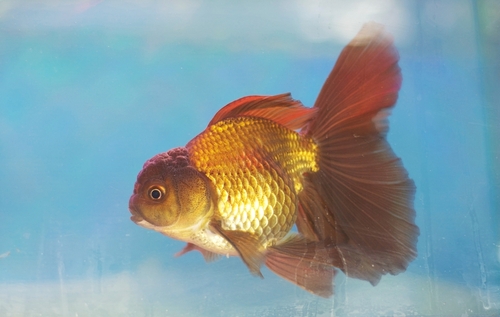Welcome to the world of Oranda goldfish, where beauty meets aquatic charm. These fancy goldfish, known for their vibrant colours and unique physical features, are a popular choice among aquarists globally.
Originating from Asia, Orandas have been selectively bred over the years, resulting in a variety of stunning colour patterns and a distinctive head growth called a “wen,” giving them a crown-like appearance.
But there’s more to these aquatic gems than just their looks. Orandas are known for their friendly and social nature, making them a delightful addition to any home aquarium.
However, these beautiful creatures require specific care and attention to thrive. From understanding their dietary needs to maintaining the right tank conditions, every aspect of their care is crucial.
So, if you’re considering adding an Oranda goldfish to your aquarium or just curious about these fascinating creatures, you’re in the right place.
Let’s dive into the captivating world of Oranda goldfish, exploring their origins, physical appearance, behaviour, and the essentials of providing them with a healthy, thriving environment.
Contents
Key Takeaways
- Oranda goldfish are a unique and popular variety of fancy goldfish known for their stunning colours and distinctive head growth called a “wen.”
- Providing proper care for oranda goldfish involves understanding their specific habitat needs, including tank setup, diet, and suitable tank mates.
- Knowledge about oranda goldfish breeding, health, and various colour variations can help aquarists maintain a thriving and visually striking home aquarium environment.
Check out these other related posts:
Oranda Goldfish Origin

The Oranda goldfish is a captivating breed of goldfish, treasured by enthusiasts worldwide. Its origin remains uncertain, but it is known to be a product of selective breeding by Asian breeders several centuries ago.
As a variant of Carassius auratus, the Oranda goldfish shares ancestry with other goldfish breeds, all of which are descendants of wild carp, specifically the Prussian carp.
Over time, breeders have worked with the natural diversity found within the wild carp population through selective breeding techniques. This has given rise to the distinct features of the Oranda goldfish, such as its prominent bubble-like “hood” on the head, which is called wen or crown.
The wen fully forms when the fish is between one to two years old and continues to grow until the fish reaches two to three years of age.
Although the exact location where the Oranda emerged is not entirely clear, it is one of the older varieties of the highly-prized fancy goldfish breed.
Their popularity has led to their distribution worldwide, where they are kept in both aquariums and ponds to soothe and delight people of all ages.
Physical Appearance
Colour Varieties
Oranda goldfish exhibit various colours, including red, black, orange, blue, white, silver, metallic, matte, yellow, and bronze.
For instance, the red cap oranda goldfish features a striking red wen on its head, while the black oranda goldfish displays a distinct black colouration. Additionally, the blue oranda showcases various shades of blue on its body.
Distinguishing Features
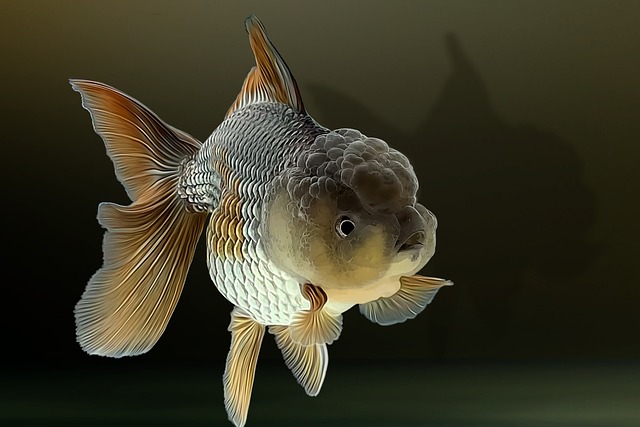
A defining characteristic of oranda goldfish is the fleshy wen or cap on their heads. This unique hood can grow in various shapes and sizes, adding to the fish’s overall appeal. In terms of size, oranda goldfish can reach up to 12 inches, depending on the living conditions and care provided.
The fins of oranda goldfish are also notable features. Their dorsal fin stands tall and erect, while a flowy, fan-like appearance characterises their caudal fin or tail fin.
The other fins, such as the pectoral and pelvic fins, have long, flowing edges contributing to the fish’s graceful swimming movements.
The crown or wen also gives oranda goldfish an interesting facial appearance, with some having red-coloured lips or other colour combinations.
Additionally, they have a hardy nature, making them suitable for various aquarium conditions. Overall, the diverse colour options and distinctive features of oranda goldfish make them popular and attractive for aquarists.
Behaviour and Temperament
Oranda goldfish are known for their peaceful and friendly temperament. These slow-moving fish are perfect additions to community aquariums, as their calm nature allows them to coexist well with other non-aggressive fish species.
In their natural environment, Oranda goldfish typically swim in groups, which makes them accustomed to social interactions. To replicate this natural setting, it is recommended to keep a group of around five or more Oranda goldfish in the same tank for proper socialisation.
An exciting aspect of Oranda goldfish behaviour is their lack of eyelids. As such, they may appear to move on the substrate when barely asleep. However, there is no cause for concern unless this inactive behaviour persists for an extended period.
Aquarists should include ample hiding spots and visually appealing decorations in the tank to provide a healthy and stimulating environment for Oranda goldfish. Live plants can further enhance the environment, offering additional exploration opportunities and places to rest.
Habitat and Tank Setup
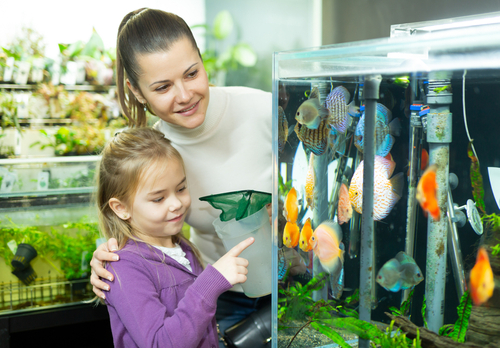
The habitat and tank setup for Oranda goldfish is essential for keeping them healthy, happy, and comfortable. This section will guide the various aspects of their habitat, including tank maintenance and water parameters.
Tank Maintenance
A well-maintained aquarium is vital for the well-being of your Oranda goldfish. Proper tank maintenance involves:
- Tank size: The minimum tank size for an Oranda goldfish is 30 gallons. Larger tanks are more stable and will allow your goldfish to thrive.
- Substrate: A fine-grained substrate like sand or smooth gravel is typically recommended, as it prevents injury to the delicate fins of your goldfish.
- Filtration: A filtration system with both mechanical and biological media is essential for keeping the tank clean and the water quality stable.
Regularly replacing items like filter cartridges and monitoring the quality of light bulbs if using lamps is also important.
Water Parameters
Oranda goldfish require specific water parameters to thrive in their aquatic environment. Here are the optimal parameters for your goldfish:
- Temperature Range: The water temperature should be maintained between 65° to 72° Fahrenheit.
- pH Range: Keep the pH levels in the range of 6.5 to 7.5.
- Water Hardness: Ensure the water hardness is between 5 to 19 dGH.
Invest in a quality water testing kit to monitor these parameters and make adjustments if needed.
By providing an appropriate habitat and diligently maintaining the tank and water quality, your Oranda goldfish will have the environment it needs to thrive, ensuring its health and well-being.
Acclimating New Oranda Goldfish
When introducing new Oranda goldfish to your aquarium, it is important to properly acclimate them to prevent shock. Start by floating the unopened bag with the new goldfish in the tank for 15-30 minutes. This allows the water inside the bag to adjust to the temperature of the aquarium.
Next, open the bag and add some tank water every 5 minutes for about 15-30 minutes. Finally, use a net to transfer the Oranda into the tank. Acclimating new goldfish gradually is crucial for avoiding stress and illness.
Feeding and Diet

Oranda goldfish have a diverse diet as they are omnivores, meaning they consume both plant- and animal-based foods. A well-balanced and nutritious diet is essential for maintaining their overall health and well-being.
Flakes and pellets formulated explicitly for goldfish can be the staple of an Oranda’s diet. These pre-made foods provide the necessary nutrients and can be found in most pet stores.
However, supplementing their diet with live or frozen foods such as brine shrimp, tubifex worms, and bloodworms adds variety to their meals and contributes to their overall growth and colouration.
In addition, Oranda goldfish can benefit from consuming natural vegetation. Algae are commonly found in aquariums and are an excellent source of nourishment for goldfish. Aside from algae, other plant-based food options include blanched spinach, lettuce, and peas.
When feeding Oranda goldfish, it is essential to regulate their food intake. Overfeeding can lead to health problems such as poor water quality and increased risk of diseases.
Feeding them small portions two to three times a day is generally recommended, ensuring that all food is consumed within a few minutes.
To ensure a well-rounded diet for your Oranda goldfish, it is vital to strike the right balance between commercial food, live or frozen options, and plant-based sources. Following a varied and nutritious meal plan, your Oranda goldfish will grow and thrive in a healthy aquarium environment.
Keeping Your Oranda Goldfish Well-Fed
Oranda goldfish are a popular aquarium fish known for their distinctive bubble-like hoods on their heads. However, caring for these fancy goldfish requires paying special attention to their feeding needs.
Unlike faster, leaner fish, orandas are prone to health issues caused by improper nutrition. Using tools like a fish feeding ring can help ensure your oranda gets the right amount and type of food.
The Problem of Uneaten Fish Food
A common problem in goldfish tanks is fish food left uneaten and floating at the top of the tank. Goldfish like orandas don’t eat as quickly as some fish. They also don’t always notice food falling to lower tank levels.
This leaves excess food to decay and foul the water. A fish tank feeding ring corrals the food in one spot and prevents it from dispersing throughout the tank.
How a Fish Feeding Ring Works
A fish feeding ring, also called an aquarium feeding ring, is a simple device that sits at the top of the water. It has a hole in the center where you can place fish food, like fish flakes or pellets.
The food stays contained within the ring instead of floating all over the tank. Your oranda and other fancy goldfish can then easily spot the food source and eat what they need.
The ring keeps any uneaten food neatly in one area for quick removal to avoid contamination. It also prevents the fish from gobbling up too much and overfeeding.
Choosing the Right Feeding Ring
When shopping for a fish tank feeding ring, look for a design specific to goldfish. Many options are sized for smaller betta fish and aren’t ideal for larger orandas.
Make sure the diameter provides ample space for the amount of fish food needed per feeding.
Also, consider durability. Acrylic plastic or silicone designs last longer than cheaper vinyl models.
Tank Mates
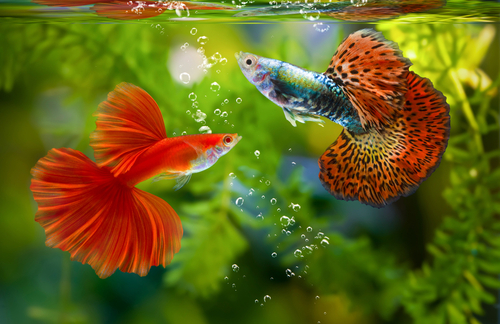
Oranda goldfish are social and peaceful creatures that can thrive in a well-maintained community tank. When selecting tank mates, it’s crucial to consider compatibility with the fancy goldfish’s unique characteristics and environmental needs.
This section will discuss some suitable tank mates for Oranda goldfish in a community tank setting.
1. Ryukin goldfish
Ryukin goldfish are a great choice as they have a similar appearance and size to Oranda goldfish, typically growing up to 6 to 7 inches in length. They share identical water conditions and diet requirements, making them compatible residents in a fancy goldfish community.
2. Black Moor goldfish
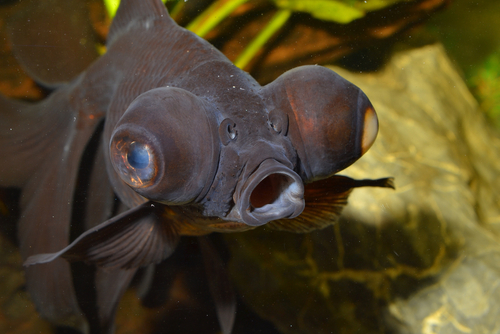
Black moor goldfish is another compatible tank mate for Oranda goldfish due to their calm temperament and shared environmental preferences. Their dark colouration provides visual contrast, enhancing the beauty of an aquarium and contributing to an exciting community of fish.
3. Ranchu goldfish
Another excellent tank mate option, as they are also a fancy goldfish variety with a gentle nature and similar needs. Their distinctive appearance, featuring a shorter body and stockier build, adds diversity to the aquarium.
When selecting tank mates for Oranda goldfish, it’s crucial to avoid aggressive or fast-swimming fish that may outcompete them for food or cause stress. Maintaining proper tank conditions and providing enough space for all inhabitants to swim and grow comfortably is also essential.
Breeding
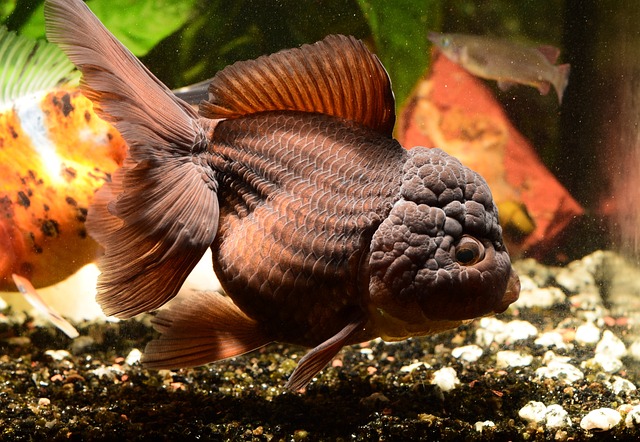
Breeding Oranda goldfish is an exciting and rewarding process for both beginners and experienced aquarists. To successfully produce these fish, understanding their reproductive habits, distinguishing between males and females, and providing optimal water conditions are essential.
Oranda goldfish typically reach sexual maturity at around 1 to 2 years of age. During the breeding season, which naturally occurs in the warmer months, males may display mating behaviour, such as chasing females around the tank.
To further increase the likelihood of successful breeding, ensure the water temperature is around 68-74°F (20-23°C) and provide plenty of plants or breeding mops for the females to lay their eggs on.
To differentiate between male and female Oranda goldfish, observing their physical characteristics is crucial. Males usually have a more elongated body shape, while females are rounder and plumper, especially when carrying eggs.
Additionally, male Orandas often develop small white bumps (tubercles) on their gill covers and pectoral fins during the breeding season. These bumps can be easily confused with ichthyophthirius multifiliis (also known as “Ich”), a common parasitic disease in aquarium fish, so make sure to monitor the overall health of your fish.
Once the eggs are laid, it’s important to separate the adults from the eggs to prevent them from being eaten. The eggs will usually hatch within 4 to 7 days. After hatching, the fry should be fed a diet rich in high-quality food, such as brine shrimp or daphnia, to ensure proper growth and development.
Health and Care
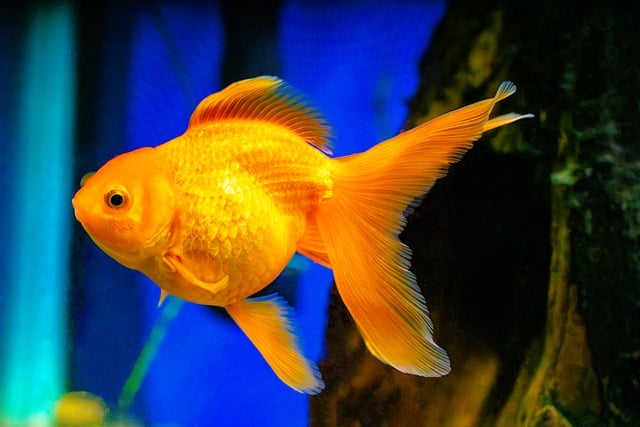
Oranda Goldfish Care
Oranda goldfish are captivating and unique pets that require adequate care and attention to thrive. With a potential lifespan of up to 15 years and an adult length between 6 and 12 inches, these fish necessitate a spacious environment and frequent water changes to maintain their well-being.
The goldfish are sensitive to ammonia, so installing a robust filtration system is essential. It’s also important to perform regular water tests to keep the parameters within the safe range.
Identifying Signs of Stress
Oranda goldfish exhibit some clear behavioral signs when stressed that you should watch for. These include erratic, darting swimming, loss of bright colors, frayed fins, hiding at the bottom of the tank, loss of appetite, and lethargy.
Rapid gill movement and gasping at the surface can also signal issues. Address any environmental stressors and monitor water parameters if these signals arise. Quarantining affected fish may help them recover.
Common Health Issues
Orandas, like all goldfish, are susceptible to various health issues, most of which can be prevented or treated with proper care. Here are some of the common health issues seen in Oranda goldfish:
- Bacterial infections: These infections can develop due to poor water quality or injury. Immediate treatment with appropriate medication is necessary to prevent the condition from worsening.
- Vision problems: One distinctive characteristic of Oranda goldfish is their hood, which can sometimes cause vision problems. Keeping the aquarium clean and free from potential hazards will minimise the risk of injuries related to poor vision.
- Sensitivity: Due to their sensitive nature, Orandas are prone to stress-related issues caused by sudden changes in water parameters or a noisy environment. Maintaining stable conditions and minimising disturbances in the aquarium will help prevent these issues.
Seasonal Care
Colder and warmer months bring fluctuating water parameters that require adjustments to Oranda goldfish care. In summer, increased algae growth may alter pH while warmer water holds less oxygen.

Adding an airstone can help. In winter, lower temperatures can suppress immune systems. Maintain tank temperature between 68-74°F and monitor ammonia since bacteria process it slower. Seasonal care helps create stable conditions for goldfish year-round.
Keep Your Goldfish Happy and Healthy
Providing proper nutrition is essential for your oranda goldfish. A fish-feeding ring takes out the guesswork and lets you easily monitor their eating habits.
While fancy goldfish require special care, a few simple tools like a feeding ring can make maintaining their health much easier.
With routine feeding and tank cleaning, your bubble-headed beauties will stay active and thrive.
Oranda Goldfish Varieties
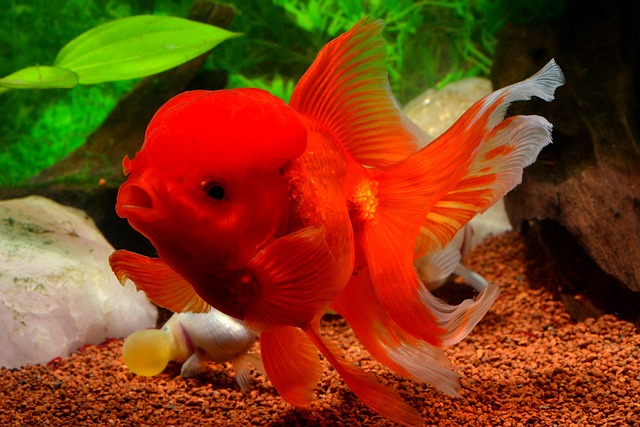
The Oranda Goldfish is a breathtaking and diverse variety of fancy goldfish that has captivated aquarists around the globe. Their unique appearance, characterised by a prominent bubble-like hood on their heads, is called a wen or crown.
The hood can vary in shape and size, covering the entire face or just the top of the head.
One popular variant of the Oranda Goldfish is the calico Oranda, also known as Azuma Nishiki. This type boasts vibrant colours and a beautiful, mottled pattern. Calico Orandas are often sought after for their stunning appearance and are considered a prized addition to aquariums and well-maintained ponds.
Besides the calico variant, Oranda Goldfish come in various colours, such as red, blue, chocolate, black, and red-and-white. The Bruce goldfish is another exciting Oranda variety known for its distinct, velvety-black colouration.
These different varieties provide a fascinating range of options for goldfish enthusiasts, allowing them to create a diverse and vibrant goldfish community in their aquariums or ponds.
As members of the Cyprinidae family, Oranda Goldfish have specific care requirements that must be met to ensure their health and longevity. They are generally considered a moderately demanding species regarding care level.
To maintain their unique appearance and support their overall health, providing a spacious environment, high-quality water filtration, a balanced diet, and regular water changes is essential.
With proper care, Oranda Goldfish can have a life expectancy of 10 to 15 years, underlining the importance of a dedicated and diligent approach to their maintenance.
The availability of these stunning goldfish is generally good, but obtaining specific varieties or colour patterns may require more effort due to varying demand and rarity among hobbyists.
Fun Facts
Oranda goldfish are unique freshwater fish known for their distinct head and vibrant colours. They are highly adaptable, and their striking beauty makes them a popular choice among aquarists.
While the average lifespan of an oranda goldfish is around 10 to 15 years, they can live up to 20 years when properly cared for. These fancy goldfish are part of the same species as the common goldfish, Carassius auratus auratus, but they boast a more elaborate appearance.
In addition to their striking look, oranda goldfish have practical advantages. They are known to be easy to care for, making them a suitable choice for beginner fish keepers.
Due to their peaceful and highly social nature, oranda goldfish can coexist with various other friendly fish in the aquarium.
When setting up an aquarium for an oranda goldfish, it’s essential to maintain a 20-gallon minimum tank size and a water temperature of 65° to 72° Fahrenheit. This environment will help them thrive, swim in all areas of the tank, and display their unique beauty.
Frequently Asked Questions
What is the ideal tank size for Oranda goldfish?
Oranda goldfish can grow between 8 and 12 inches in length, so providing them with a spacious tank is crucial.
A general rule is to have a 20-gallon aquarium for the first goldfish and an additional 10 gallons for each subsequent goldfish. This space allows ample room for swimming and assists in diluting high amounts of ammonia.
How often should Oranda goldfish be fed?
Feed Oranda goldfish 2-3 times daily with high-quality pellets or flake food. Provide only as much food as they can consume within two minutes to prevent overfeeding. Supplement their diet with occasional treats, such as vegetables or live brine shrimp, to provide additional nutrients.
What are suitable tank mates for Oranda goldfish?
Oranda goldfish are generally peaceful and can coexist with other non-aggressive fish species that thrive in similar water conditions.
Suitable tank mates include different goldfish varieties, such as the Ryukin, Telescope, and Pearlscale, or even hardy, cold-water fish like White Cloud Mountain Minnows and Rosy Barbs.
However, avoid keeping them with aggressive or fast-swimming fish that may outcompete them for food or cause stress.
What is the lifespan of an Oranda goldfish?
With proper care, on average, Oranda goldfish can live between 10 and 15 years. Some individuals have been reported to live even longer when given optimal living conditions, including a well-maintained aquarium, a balanced diet, and proper water parameters.
How to properly care for Oranda goldfish?
To care for Oranda goldfish, provide a spacious tank with adequate filtration and a stable water temperature between 65°F and 72°F. Use high-quality goldfish food and feed them 2-3 times a day, making sure not to overfeed.
Regularly test the water for ammonia, nitrite, and nitrate levels, and perform partial water changes as needed to maintain optimal water quality. Additionally, include hiding spots and live plants to create a comfortable environment for your goldfish.
What distinguishes Oranda goldfish from other types?
Oranda goldfish are unique in their appearance. A prominent head growth characterises them, called a wen, which can resemble a crown or raspberry-like structure. This growth can continue to develop throughout their life, adding to their distinct appearance.

Ian Sterling, founder of Fishlab.com, began his aquarium journey over 30 years ago, driven by a deep fascination for fish and their diverse personalities. His website, Fishlab.com, is dedicated to making fishkeeping accessible and enjoyable, offering beginner-friendly guidance, expert insights, and a community for aquarists to connect and share experiences.


